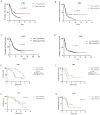Hydrogen Sulfide Expression May Affect Ovarian Cancer Progression and Drug Resistance
- PMID: 40453043
- PMCID: PMC12126979
- DOI: 10.2147/IJWH.S515836
Hydrogen Sulfide Expression May Affect Ovarian Cancer Progression and Drug Resistance
Abstract
Objective: The present study aimed to evaluated the expression profiles of the Hydrogen sulfide (H2S)-synthesizing enzymes cystathionine β-synthase (CBS) and cystathionine γ-lyase (CSE) expression and attempted to establish its relationship to ovarian cancer (OV) drug resistance and prognosis.
Methods: The expression levels of cystathionine β-synthase (CBS) and cystathionine γ-lyase (CSE) were analyzed in OV from GSE26193 and GSE14764 datasets, and OVCAR8 cisplatin resistant cell line from GSE45553 datasets. The correlation between prognosis with CBS and CSE expression levels were analyzed in OV from GSE26193 dataset. Immunohistochemical (IHC) analysis of CBS and CSE expression, meanwhile Kaplan-Meier analyzed of corresponding prognosis in OV patients. The relative drug sensitivity of CBS and CSE genes via gene set cancer analysis. Ultimately, the correlations among OV immune cells, CBS, and CSE. The CBS and CSE expression levels, and pan-cancer prognosis using TCGA database.
Results: CBS and CSE were significantly overexpressed in the OV and OVCAR8 cisplatin resistant cell line (GSE26193: p < 0.001 and p < 0.0001; GSE14764: p < 0.001 and p < 0.0001 IHC: p<0.0001 and p<0.0001; GSE45553: p < 0.0001 and p < 0.0001, respectively). Interestingly, CBS is closely associated with OS and PFS in GSE26193 dataset and OV patients (GSE26193: PFS, p = 0.0391; OS, p = 0.0328. OV patients: PFS, p= 0.017; OS, p=0.030). The CBS and CSE expression levels were correlated with immune cells, CD4 T cells, neutrophils, macrophages, and dendritic cells (DC) and their respective infiltration scores significantly differed. Both CBS and CSE expression levels influenced pan-cancer prognosis.
Conclusion: H2S overexpression affected the OS and PFS and could also have an impact on the drug resistance of OV. Pan cancer prognosis may vary with H2S expression.
Keywords: drug resistance; hydrogen sulfide; immune cell; ovarian cancer; pan-cancer; progression.
© 2025 Zhu et al.
Conflict of interest statement
The authors have no known conflicts of interest to declare for this work.
Figures







References
-
- Webb PM, Jordan SJ. Global epidemiology of epithelial ovarian cancer. Nat Rev Clin Oncol. 2024;21(5):389–400. - PubMed
LinkOut - more resources
Full Text Sources
Research Materials

